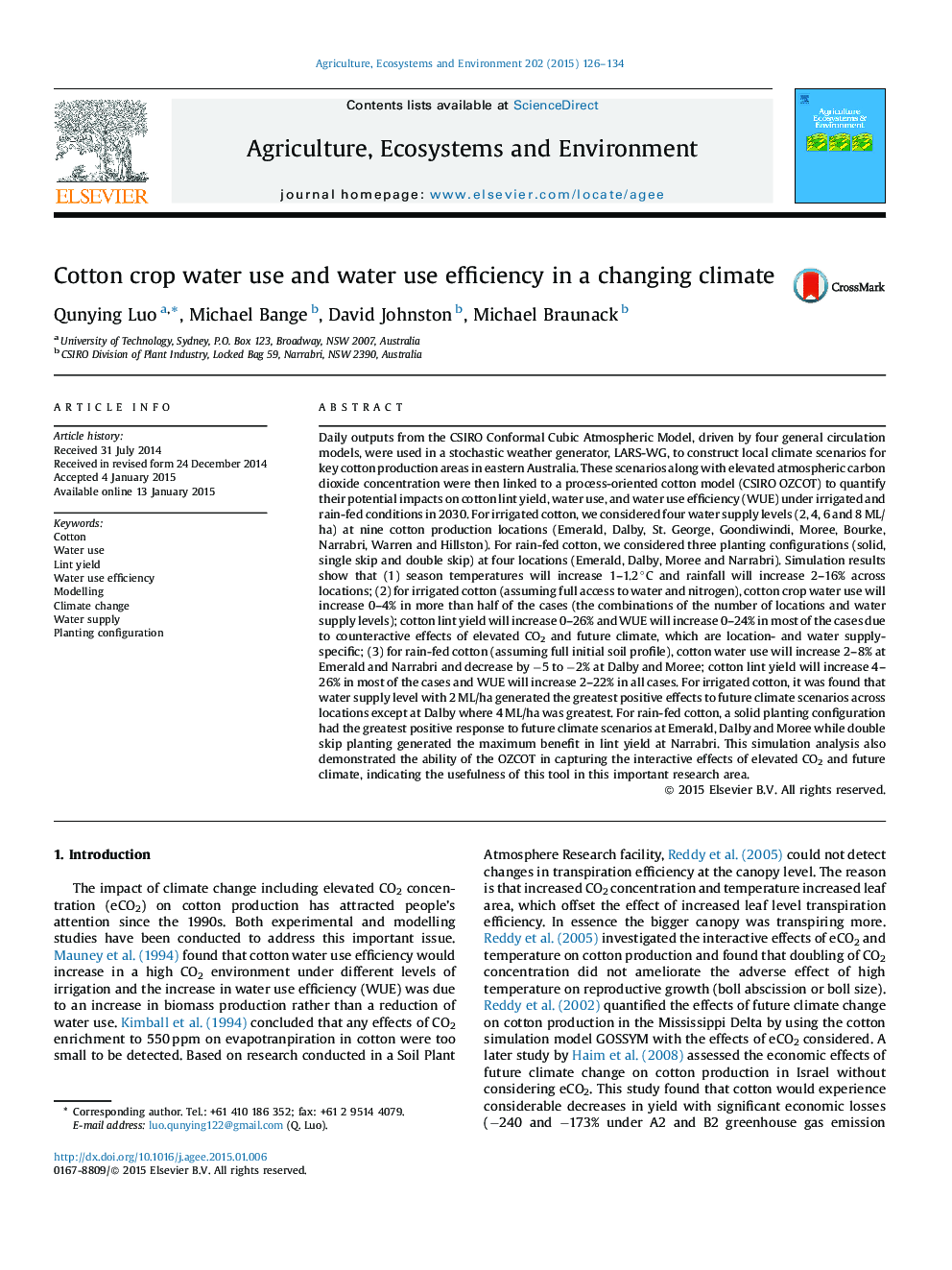| کد مقاله | کد نشریه | سال انتشار | مقاله انگلیسی | نسخه تمام متن |
|---|---|---|---|---|
| 2413770 | 1552050 | 2015 | 9 صفحه PDF | دانلود رایگان |
• The OZCOT captured the interactive effects of enhanced CO2 and climate change.
• Yield, water use and WUE increased for irrigated cotton in a changing climate.
• Water supply level of 2 ML/ha generated the greatest benefits under climate change.
• Yield and WUE increased while water use increased/decreased for rain-fed cotton.
• Solid configuration generated the greatest benefit in a changing climate.
Daily outputs from the CSIRO Conformal Cubic Atmospheric Model, driven by four general circulation models, were used in a stochastic weather generator, LARS-WG, to construct local climate scenarios for key cotton production areas in eastern Australia. These scenarios along with elevated atmospheric carbon dioxide concentration were then linked to a process-oriented cotton model (CSIRO OZCOT) to quantify their potential impacts on cotton lint yield, water use, and water use efficiency (WUE) under irrigated and rain-fed conditions in 2030. For irrigated cotton, we considered four water supply levels (2, 4, 6 and 8 ML/ha) at nine cotton production locations (Emerald, Dalby, St. George, Goondiwindi, Moree, Bourke, Narrabri, Warren and Hillston). For rain-fed cotton, we considered three planting configurations (solid, single skip and double skip) at four locations (Emerald, Dalby, Moree and Narrabri). Simulation results show that (1) season temperatures will increase 1–1.2 °C and rainfall will increase 2–16% across locations; (2) for irrigated cotton (assuming full access to water and nitrogen), cotton crop water use will increase 0–4% in more than half of the cases (the combinations of the number of locations and water supply levels); cotton lint yield will increase 0–26% and WUE will increase 0–24% in most of the cases due to counteractive effects of elevated CO2 and future climate, which are location- and water supply-specific; (3) for rain-fed cotton (assuming full initial soil profile), cotton water use will increase 2–8% at Emerald and Narrabri and decrease by −5 to −2% at Dalby and Moree; cotton lint yield will increase 4–26% in most of the cases and WUE will increase 2–22% in all cases. For irrigated cotton, it was found that water supply level with 2 ML/ha generated the greatest positive effects to future climate scenarios across locations except at Dalby where 4 ML/ha was greatest. For rain-fed cotton, a solid planting configuration had the greatest positive response to future climate scenarios at Emerald, Dalby and Moree while double skip planting generated the maximum benefit in lint yield at Narrabri. This simulation analysis also demonstrated the ability of the OZCOT in capturing the interactive effects of elevated CO2 and future climate, indicating the usefulness of this tool in this important research area.
Journal: Agriculture, Ecosystems & Environment - Volume 202, 1 April 2015, Pages 126–134
